
a) NaBH4 and H3O+
Interpretation:
The products produced when 1) phenylacetaldehyde and 2) acetophenone are treated first with NaBH4 and then with H3O+ are to be given.
Concept introduction:
NaBH4, either in water or in alcohol reduce
To give:
The products produced when 1) phenylacetaldehyde and 2) acetophenone are treated first with NaBH4 and then with H3O+.
Answer to Problem 58AP
The product produced when 1) phenylacetaldehyde is treated first with NaBH4 and then with H3O+ is 2-phenylethanol.
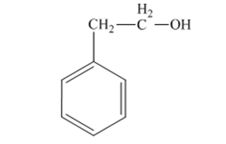
The product produced when acetophenone is treated first with NaBH4 and then with H3O+ is 1-phenylethanol.
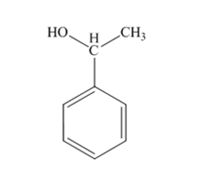
Explanation of Solution
Phenylacetaldehyde, being an aldehyde is reduced by NaBH4 to a primary alcohol, 2-phenylethanol.
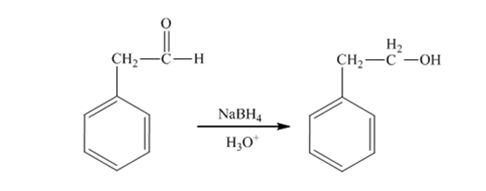
Acetophenone, being a ketone is reduced by NaBH4 to a secondary alcohol, 1-phenylethanol.
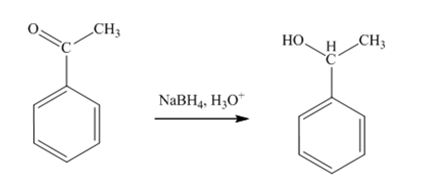
The product produced when 1) phenylacetaldehyde is treated first with NaBH4 and then with H3O+ is 2-phenylethanol.

The product produced when acetophenone is treated first with NaBH4 and then with H3O+ is 1-phenylethanol.

b) Dess-Martin reagent
Interpretation:
The products produced when 1) phenylacetaldehyde and 2) acetophenone are treated with Dess-Martin reagent are to be given.
Concept introduction:
Aldehydes and ketones are not oxidized by Dess-Martin reagent.
To give:
The products produced when 1) phenylacetaldehyde and 2) acetophenone are treated with Dess-Martin reagent.
Answer to Problem 58AP
Phenylacetaldehyde does not react with Dess-Martin reagent.
Acetophenone does not react with Dess-Martin reagent.
Explanation of Solution
Aldehydes and ketones are not oxidized by Dess-Martin reagent.
Phenylacetaldehyde does not react with Dess-Martin reagent.
Acetophenone does not react with Dess-Martin reagent.
c) NH2OH, HCl catalyst
Interpretation:
The products produced when 1) phenylacetaldehyde and 2) acetophenone are treated with NH2OH in the presence of HCl catalyst are to be given.
Concept introduction:
Aldehydes and ketones react with hydroxyl amne in the presence of an acid catalyst to yield aloximes and ketoximes respectively.
To give:
The products produced when 1) phenylacetaldehyde and 2) acetophenone are treated with NH2OH in the presence of HCl catalyst.
Answer to Problem 58AP
The product produced when phenylacetaldehyde is treated with NH2OH in the presence of HCl catalyst is
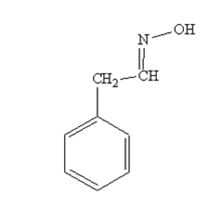
The product produced when acetophenone is treated with NH2OH in the presence of HCl catalyst is
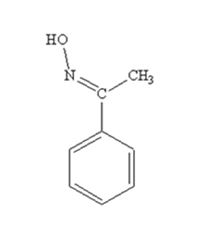
Explanation of Solution
phenylacetaldehyde reacts with NH2OH in the presence of HCl catalystto yield phenylacetaldoxime.
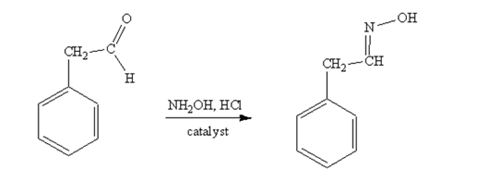
Acetophenone reacts with NH2OH in the presence of HCl catalyst to give acetophenoneoxime.
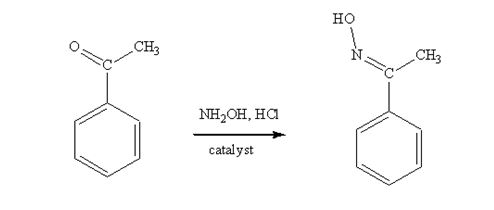
The product produced when phenylacetaldehyde is treated with NH2OH in the presence of HCl catalyst is

The product produced when acetophenone is treated with NH2OH in the presence of HCl catalyst is

d) CH3MgBr and H3O+
Interpretation:
The products produced when 1) phenylacetaldehyde and 2) acetophenone are treated first with CH3MgBr and then with H3O+ are to be given.
Concept introduction:
On treatment with Grignard reagents followed by acidification, aldehydes other than formaldehyde yield secondary alcohols and ketones give tertiary alcohols.
To give:
The products produced when 1) phenylacetaldehyde and 2) acetophenone are treated first with CH3MgBr and then with H3O+.
Answer to Problem 58AP
The product produced when phenylacetaldehyde is treated first with CH3MgBr and then with H3O+ is
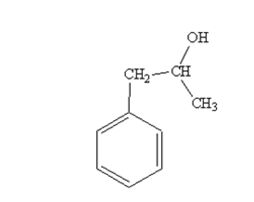
The products produced when acetophenone is treated first with CH3MgBr and then with H3O+ is
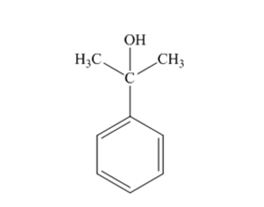
Explanation of Solution
When phenylacetaldehyde is treated first with CH3MgBr and then with H3O+ the product produced is 1-phenyl-2-propanol, a secondary alcohol.
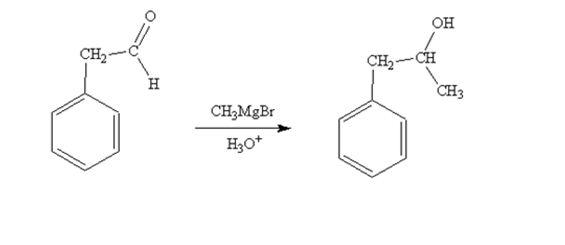
When acetophenone is treated first with CH3MgBr and then with H3O+ the product produced is 2-phenyl-2-propanol, a tertiary alcohol.
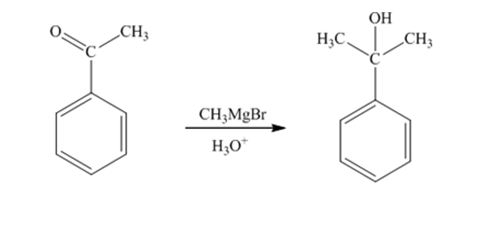
The product produced when phenylacetaldehyde is treated first with CH3MgBr and then with H3O+ is

The products produced when acetophenone is treated first with CH3MgBr and then with H3O+ is

e) CH3OH, HCl catalyst
Interpretation:
The products produced when 1) phenylacetaldehyde and 2) acetophenone are treated with two equivalents of CH3OH in the presence of HCl catalyst are to be given.
Concept introduction:
Aldehydes react reversibley with two equivalents of an alcohol in the presence of an acid catalyst to yield acetals and ketones react to give ketals.
To give:
The product produced when phenylacetaldehyde is treated with two equivalents of CH3OH in the presence of HCl catalyst.
Answer to Problem 58AP
The product produced when phenylacetaldehyde is treated with two equivalents of CH3OH in the presence of HCl catalyst is
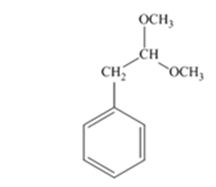
The product produced when acetophenone is treated with two equivalents of CH3OH in the presence of HCl catalyst is
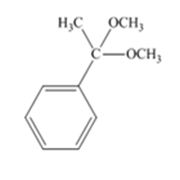
Explanation of Solution
Phenylacetaldehyde reacts with two equivalents of CH3OH in the presence of HCl catalyst to yield an acetal.
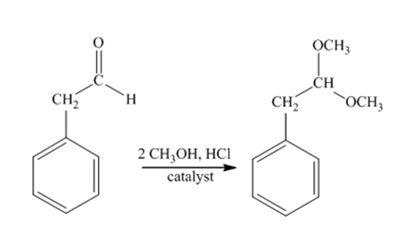
Acetophenone reacts with two equivalents of CH3OH in the presence of HCl catalyst to yield a ketal.

The product produced when phenylacetaldehyde is treated with two equivalents of CH3OH in the presence of HCl catalyst is

The product produced when acetophenone is treated with two equivalents of CH3OH in the presence of HCl catalyst is

f) NH2NH2, KOH
Interpretation:
The product produced when 1) phenylacetaldehyde and 2) acetophenone are treated with NH2NH2 in the presence of KOH are to be given.
Concept introduction:
The aldehydes and ketones undergo Wolff-Kishner reduction to yield
To give:
The product produced when 1) phenylacetaldehyde and 2) acetophenone are treated first with NH2NH2 and KOH.
Answer to Problem 58AP
The product produced when phenylacetaldehyde is treated with NH2NH2 and KOH is
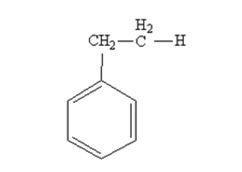
The product produced when acetophenone is treated with NH2NH2 and KOH is
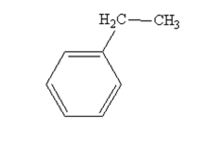
Explanation of Solution
Phenylacetaldehyde is reduced by NH2NH2 and KOH to ethylbenzene.
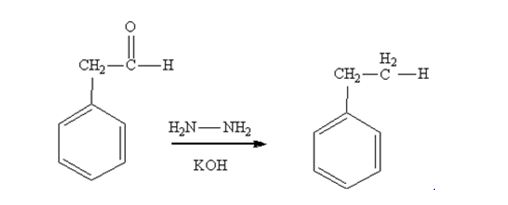
Acetophenone also is reduced by NH2NH2 and KOH to ethylbenzene.
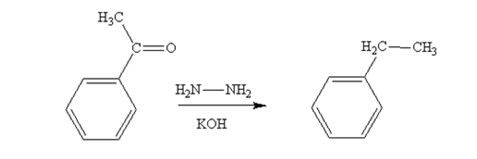
The product produced when phenylacetaldehyde is treated with NH2NH2 and KOH is

The product produced when acetophenone is treated with NH2NH2 and KOH is

g) (C6H5)3P=CH2
Interpretation:
The products produced when 1) phenylacetaldehyde and 2) acetophenone are treated with (C6H5)3P=CH2 are to be given.
Concept introduction:
The reaction given is Wittig reaction. Aldehydes and ketones are converted into
To give:
The products produced when 1) phenylacetaldehyde and 2) acetophenone are treated with (C6H5)3P=CH2.
Answer to Problem 58AP
The product produced when phenylacetaldehyde is treated with (C6H5)3P=CH2 is

The product produced when acetophenone are treated with (C6H5)3P=CH2 is
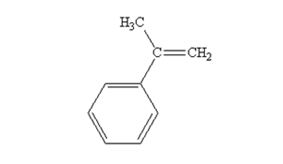
Explanation of Solution
Phenylacetaldehyde reacts with with (C6H5)3P=CH2 to yield 3-phenylpropene.
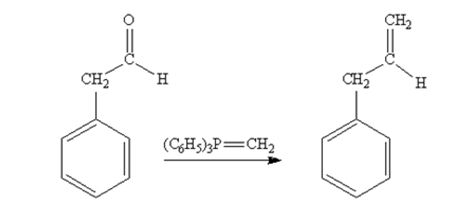
Acetophenone reacts with with (C6H5)3P=CH2 to yield 2-phenylpropene.
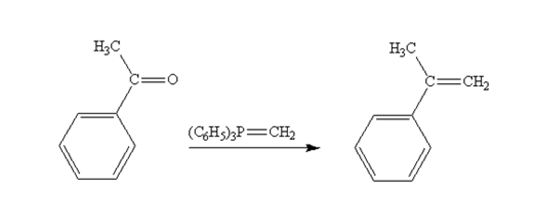
The product produced when phenylacetaldehyde is treated with (C6H5)3P=CH2 is

The product produced when acetophenone are treated with (C6H5)3P=CH2 is

h) HCN, KCN
Interpretation:
The products produced when 1) phenylacetaldehyde and 2) acetophenone are treated with HCN, KCN are to be given.
Concept introduction:
Aldehydes and ketones undergo nucleophilic addition reaction.
To give:
The products produced when 1) phenylacetaldehyde and 2) acetophenone are treated first with HCN, KCN to yield their cyanohydrins.
Answer to Problem 58AP
The product produced when phenylacetaldehyde is treated with HCN, KCN is
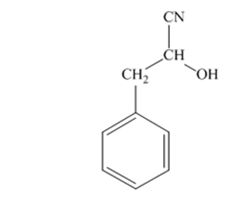
The products produced when acetophenone is treated with HCN, KCN is
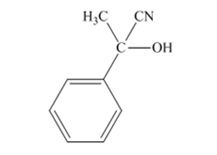
Explanation of Solution
When phenylacetaldehyde is treated with HCN, KCN, it gives phenylacetaldehydecyanohydrin.
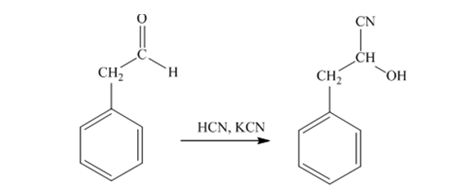
When acetophenone is treated with HCN, KCN, it gives acetophenonecyanohydrin.
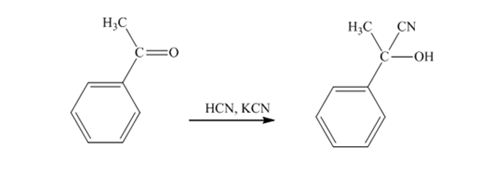
The product produced when phenylacetaldehyde is treated with HCN, KCN is

The products produced when acetophenone is treated with HCN, KCN is

Want to see more full solutions like this?
Chapter 11 Solutions
Student Value Bundle: Organic Chemistry, + OWLv2 with Student Solutions Manual eBook, 4 terms (24 months) Printed Access Card (NEW!!)
- Understanding the general acid-base properties of amino acids O Proteins Imagine each of the molecules shown below was found in an aqueous solution. Can you tell whether the solution is acidic, basic, or neutral? molecule The solution is... 010 H3N-CH-C-OH CH HO CH3 O acidic O basic neutral O (unknown) H3N HO 0 O acidic O basic neutral ○ (unknown) H3N-CH-C-O CH2 CH3-CH-CH3 O acidic O basic Oneutral ○ (unknown) O= X H2N-CH-C-O CH3 CH CH3 acidic O basic O neutral ○ (unknown) ? 000arrow_forwardImagine each of the molecules shown below was found in an aqueous solution. Can you tell whether the solution is acidic, basic, or neutral? molecule 0=0 H3N-CH-C-o HO CH2 OH The solution is... O acidic O basic O neutral O (unknown) H₂N acidic O basic O neutral ○ (unknown) + H3N O OH O acidic O basic O neutral O (unknown) H2N-CH-C-O CH3 O acidic O basic neutral ○ (unknown) X ? olo HEarrow_forwardRecognizing ampli Draw an a amino acid with a methyl (-CH3) side chain. Explanation Check Click and drag to start drawing a structure. X Carrow_forward
- Write the systematic name of each organic molecule: structure name × HO OH ☐ OH CI CI O CI OH OHarrow_forwardく Check the box under each a amino acid. If there are no a amino acids at all, check the "none of them" box under the table. Note for advanced students: don't assume every amino acid shown must be found in nature. COO H3N-C-H CH2 HO CH3 NH3 O CH3-CH CH2 OH Onone of them Explanation Check + H3N O 0. O OH + NH3 CH2 CH3-CH H2N C-COOH H O HIC + C=O H3N-C-O CH3- - CH CH2 OH Х 2025 McGraw Hill LLC. All Rights Reserved. Terms of Use | Privacy Center Accesarrow_forwardWrite the systematic name of each organic molecule: structure HO-C-CH2-CH3 O -OH CH3-CH2-CH2-CH2-CH2-C-OH CH3 CH3-CH-CH2-C-OH Explanation Check S namearrow_forward
- theres 2 productsarrow_forwardDraw the major product of this solvolysis reaction. Ignore any inorganic byproducts. + CH3CH2OH Drawing Q Atoms, Bonds and Rings OCH2CH3 || OEt Charges OH 00-> | Undo Reset | Br Remove Done Drag To Pan +arrow_forwardDraw the major product of this SN1 reaction. Ignore any inorganic byproducts. CH3CO2Na CH3CO2H Drawing + Br Q Atoms, Bonds and Rings OAC Charges OH ОАс Na ဂ Br Undo Reset Remove Done Drag To Pan +arrow_forward
- Organic Functional Groups entifying positions labeled with Greek letters in acids and derivatives 1/5 ssible, replace an H atom on the a carbon of the molecule in the drawing area with a ce an H atom on the ẞ carbon with a hydroxyl group substituent. ne of the substituents can't be added for any reason, just don't add it. If neither substi er the drawing area. O H OH Oneither substituent can be added. Check D 1 Accessibility ado na witharrow_forwardDifferentiate between electrophilic and nucleophilic groups. Give examples.arrow_forwardAn aldehyde/ketone plus an alcohol gives a hemiacetal, and an excess of alcohol gives an acetal. The reaction is an equilibrium; in aldehydes, it's shifted to the right and in ketones, to the left. Explain.arrow_forward

 Organic ChemistryChemistryISBN:9781305580350Author:William H. Brown, Brent L. Iverson, Eric Anslyn, Christopher S. FootePublisher:Cengage Learning
Organic ChemistryChemistryISBN:9781305580350Author:William H. Brown, Brent L. Iverson, Eric Anslyn, Christopher S. FootePublisher:Cengage Learning Organic Chemistry: A Guided InquiryChemistryISBN:9780618974122Author:Andrei StraumanisPublisher:Cengage Learning
Organic Chemistry: A Guided InquiryChemistryISBN:9780618974122Author:Andrei StraumanisPublisher:Cengage Learning


